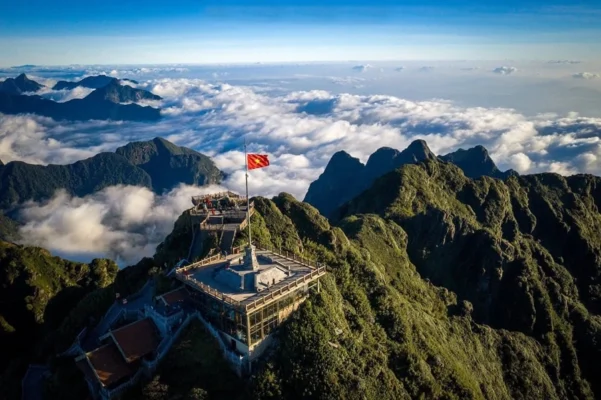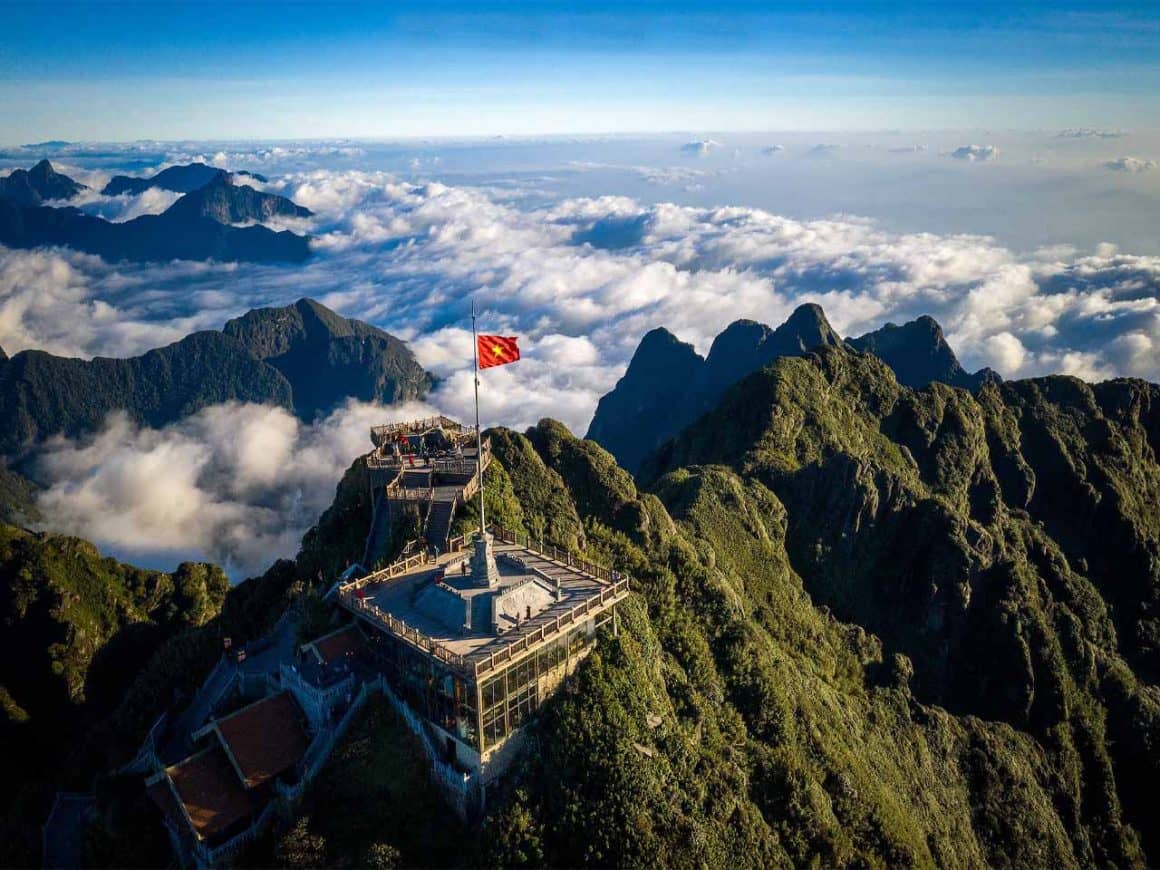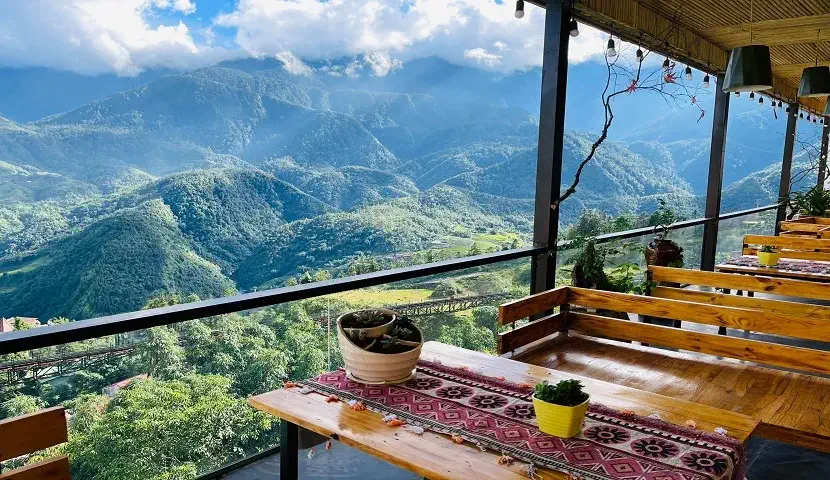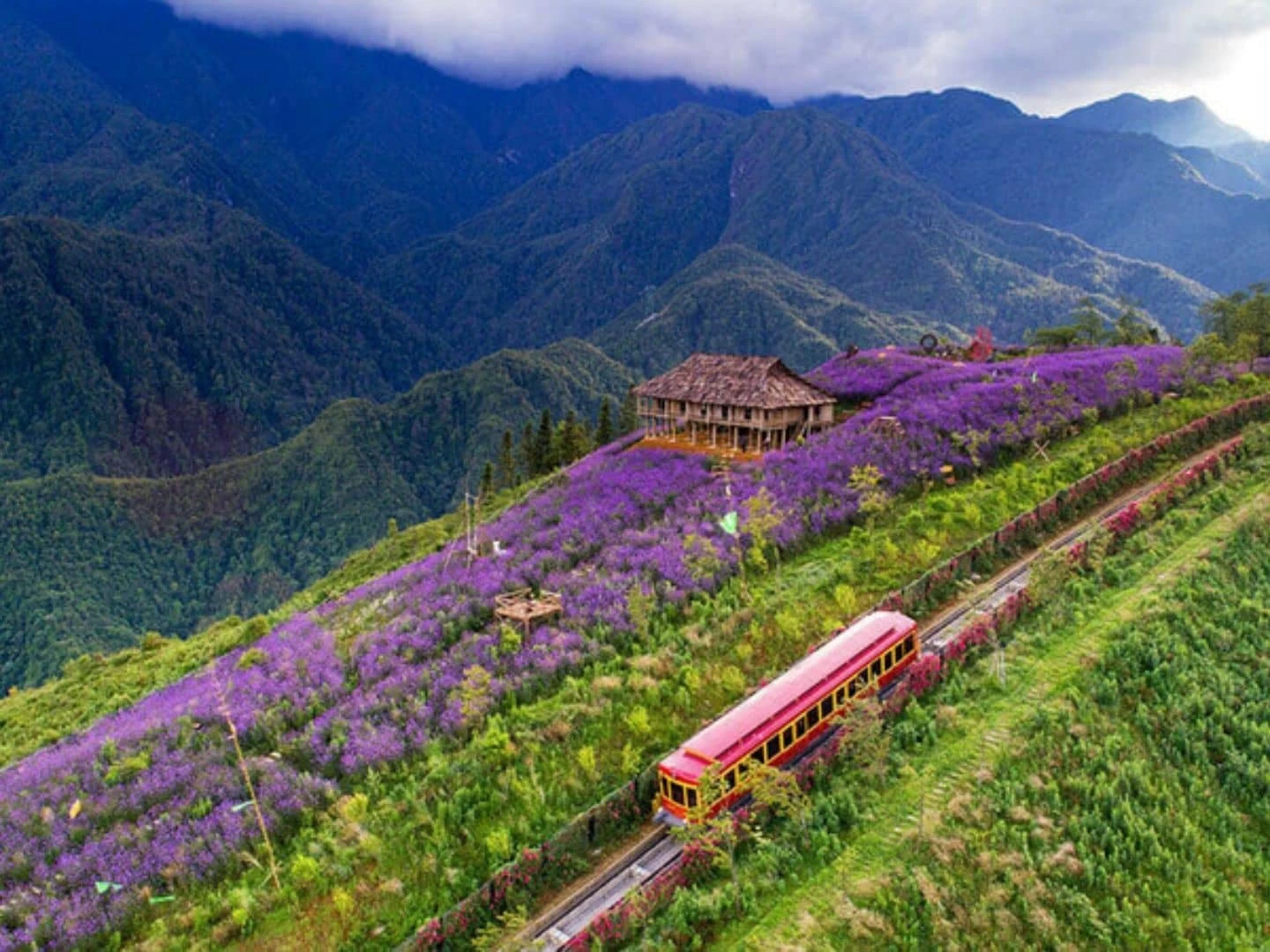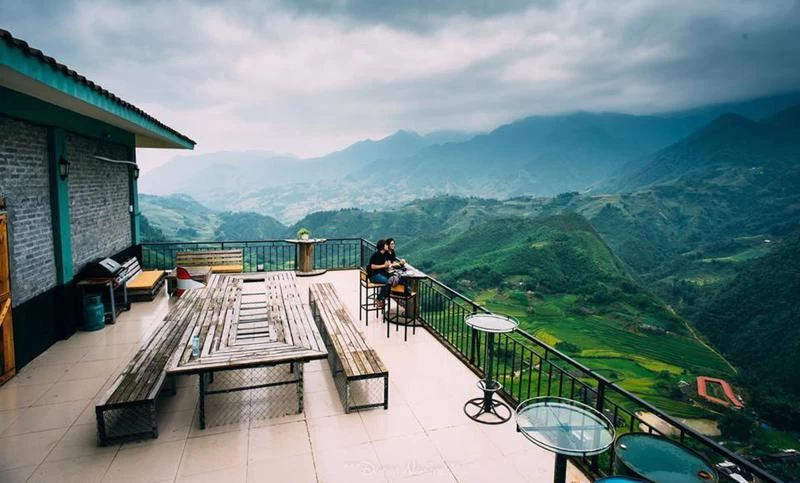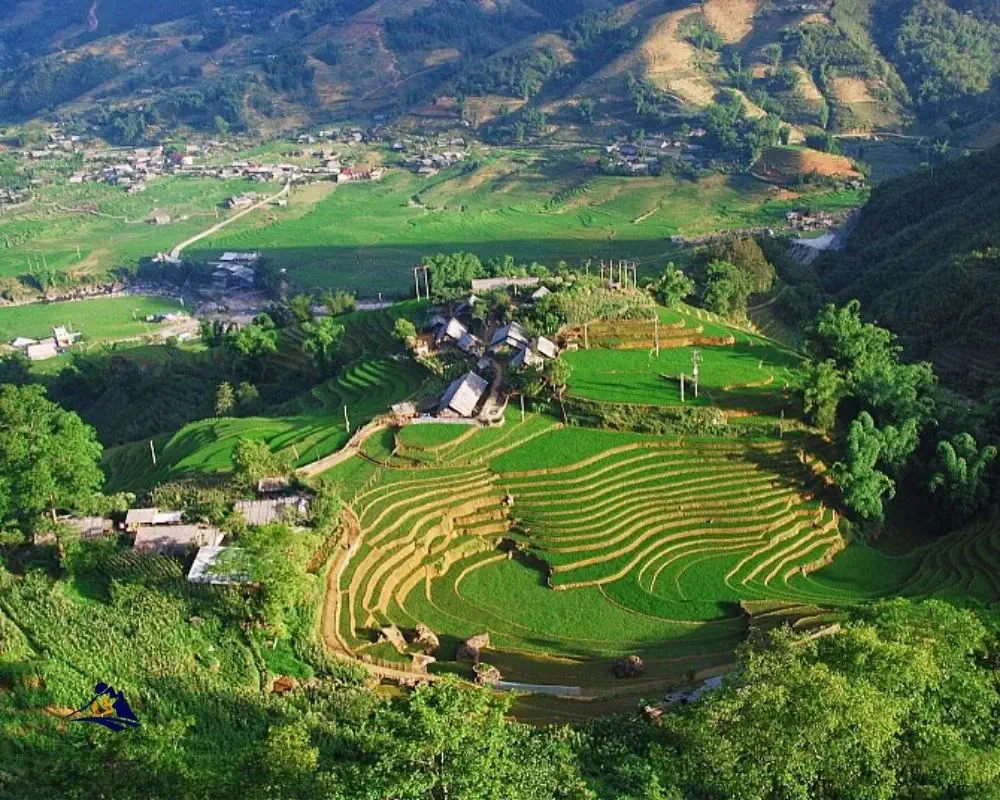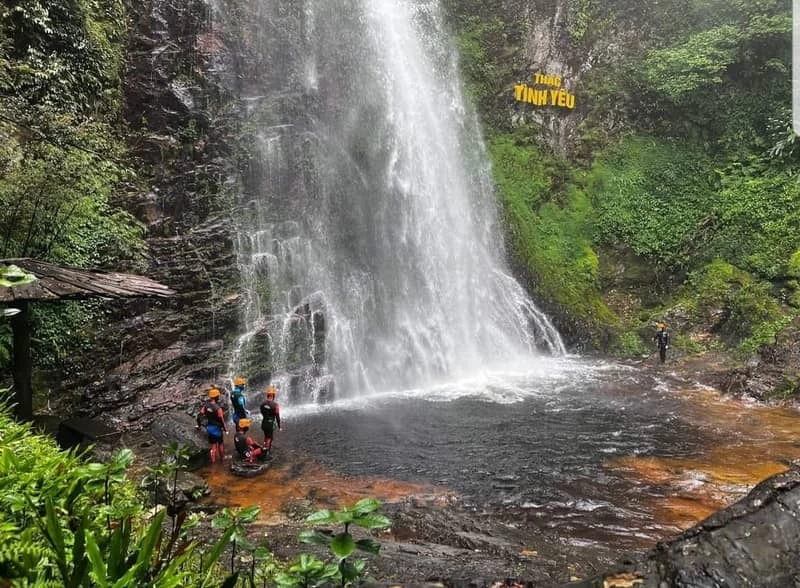
Let’s explore the journey from Hanoi to Sapa.
Discover the ultimate adventure with our Hanoi to Sapa tours! Experience breathtaking landscapes, vibrant local culture, and unforgettable activities in northern Vietnam. Our all-inclusive tours offer convenient transportation, expert guides, and customizable itineraries to explore the stunning mountains, lush valleys, and traditional villages of Sapa. Ideal for international travelers seeking an immersive journey through Vietnam’s natural beauty and cultural heritage. Book your tour with Ula Travel today and embark on a journey from Hanoi to Sapa!
I. Introduction to Sapa
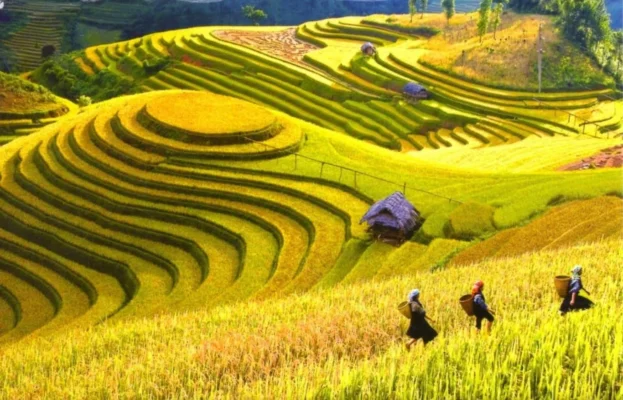
Sapa is famous for its natural beauty and rich culture.
Nestled in the northern highlands of Vietnam, Sapa is a captivating destination that draws travelers worldwide with its breathtaking natural landscapes, rich cultural heritage, and the vibrant traditions of ethnic minority communities.
Known for its terraced rice fields that cascade down mountainsides, misty valleys, and the towering peak of Mount Fansipan—often referred to as the “Roof of Indochina”—Sapa offers a scenic retreat for nature lovers and adventure seekers alike.
Beyond its natural beauty, Sapa is home to diverse ethnic groups such as the Hmong, Dao, and Tay, who preserve age-old traditions, colorful markets, and unique handicrafts. These cultural elements, combined with the region’s stunning geography, create a one-of-a-kind experience for international visitors.
II. How to Get from Hanoi to Sapa
1. Train
The train journey begins at Hanoi Railway Station and ends at Lao Cai Railway Station. Lao Cai is the closest major town to Sapa, located about 38 kilometers away. Once you arrive in Lao Cai, you’ll need to take a bus, shuttle, or taxi to reach Sapa, which takes around 1 hour.
- Travel Time: The train journey from Hanoi to Lao Cai typically takes around 8 to 9 hours, depending on the specific train. Most tourists prefer taking the overnight train, departing Hanoi in the evening and arriving in Lao Cai early in the morning, giving them a full day to explore Sapa.
2. Bus
Taking a bus is one of the most popular and straightforward ways to travel from Hanoi to Sapa. The buses run directly between the two locations, making it a convenient option for most travelers. The route typically follows the Hanoi-Lao Cai Highway, providing a comfortable and relatively smooth journey through scenic mountain landscapes.
- Travel Time: The bus journey from Hanoi to Sapa generally takes 5 to 6 hours. The travel time may vary depending on road conditions, weather, and traffic.
3. Private Car
For those seeking comfort and flexibility, renting a private car is an excellent option. Several car rental companies in Hanoi offer vehicles with professional drivers who are familiar with the mountainous terrain. Private cars allow you to travel at your own pace, with opportunities to stop and enjoy scenic spots along the way.
- Travel Time: Traveling by private car typically takes around 5 to 6 hours. The flexibility of stopping for breaks, sightseeing, or meals makes this option appealing for families or small groups.
III. Itineraries for the Hanoi to Sapa Tour
1. A Deeper Exploration with Outdoor Activities: 3 Days 2 Nights
For travelers with more time, this itinerary offers a more immersive experience in Sapa. Here’s a typical breakdown:
- Day 1: Departure from Hanoi by night train or bus. You’ll arrive in Sapa early the next morning and begin exploring local markets or start a short trek to villages like Ta Phin, famous for its Red Dao community.
- Day 2: A full day of trekking through some of Sapa’s most stunning landscapes, including Lao Chai and Ta Van villages. The hike covers diverse terrain, from terraced fields to bamboo forests, providing plenty of opportunities to connect with the locals and learn about their traditional lifestyles.
- Day 3: Visit Fansipan Mountain, either by cable car or trekking for more adventurous travelers. After lunch, you’ll have free time to explore Sapa town before departing back to Hanoi in the late afternoon or evening.
Highlights:
- More time for trekking and cultural interaction
- Exploring remote villages and natural landscapes
- Option to visit Fansipan, the “Roof of Indochina.”
Read more: Hanoi to Sapa Private Tour
2. Comprehensive Sapa Experience: 4 Days 3 Nights
For those seeking a more leisurely pace or wishing to explore beyond Sapa, a 4-5 days itinerary is ideal.
- Day 1-2: Similar to the 3-day itinerary, these days focus on trekking through iconic villages and exploring Sapa’s key attractions.
- Day 3: A visit to Bac Ha Market (typically held on Sundays), known for its vibrant atmosphere and rich cultural displays by ethnic minorities. Alternatively, you can venture to Y Ty, a hidden gem famous for its misty landscapes and less-visited villages.
- Day 4: Depending on the route, you may explore further into remote areas, engage in more trekking, or simply relax in a homestay, soaking in the serene surroundings. The return to Hanoi is usually scheduled for the evening of the final day.
Highlights:
- Extensive trekking routes and off-the-beaten-path destinations
- Unique cultural experiences in less commercialized areas like Y Ty
- A comprehensive tour for those who want to fully immerse themselves in the mountainous region.
More Detail: Northern Vietnam Itinerary
IV. Top Attractions in Sapa Tour
1. Fansipan Mountain: Conquering the “Roof of Indochina”
Fansipan, standing at 3,143 meters, is known as the “Roof of Indochina” and is the highest peak in the region. This majestic mountain is a must-visit for adventure seekers and nature enthusiasts. There are two main ways to reach the summit:
- Cable Car Ride: The ride takes about 15 minutes, offering breathtaking views of terraced fields, lush valleys, and cloud-covered peaks. Once you reach the top, a short climb up 600 steps leads you to the summit, where you can take in the awe-inspiring scenery and capture unforgettable photos.
- Trekking Adventure: For those who prefer a more challenging and immersive experience, trekking to the top of Fansipan is an option. There are guided tours available, typically lasting two to three days. This trek allows you to explore diverse flora and fauna while experiencing the rugged beauty of Sapa’s landscapes.
2. Cat Cat Village: A Glimpse into H’Mong Culture
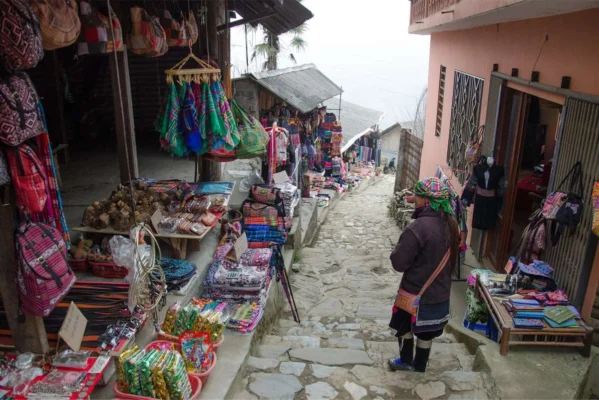
Cat Cat Village with pristine beauty and unique culture.
Located just 2 kilometers from Sapa town, Cat Cat Village is one of the oldest and most picturesque ethnic villages in the region. It’s home to the Black H’Mong people, who have preserved their unique customs, traditions, and handicrafts over centuries.
- Cultural Exploration: As you stroll through the village, you’ll encounter traditional wooden houses, terraced fields, and workshops where the locals produce handwoven fabrics and crafts. Visitors have the opportunity to learn about the intricate process of creating indigo-dyed clothing and to purchase authentic handmade products as souvenirs.
- Village Life Experience: The daily life of the H’Mong people unfolds in front of you as you interact with friendly locals, observe their agricultural activities, and learn about their unique traditions. The village is set against a backdrop of rolling hills and cascading waterfalls, providing a serene and photogenic environment.
- Cultural Performances: In Cat Cat Village, you can also witness traditional music and dance performances, offering deeper insights into the rich heritage of the H’Mong community. These shows are often organized for visitors and provide a lively display of folk culture.
Start your journey with: Sapa Tour from Hanoi 7 Days
3. Muong Hoa Valley and Terraced Rice Fields
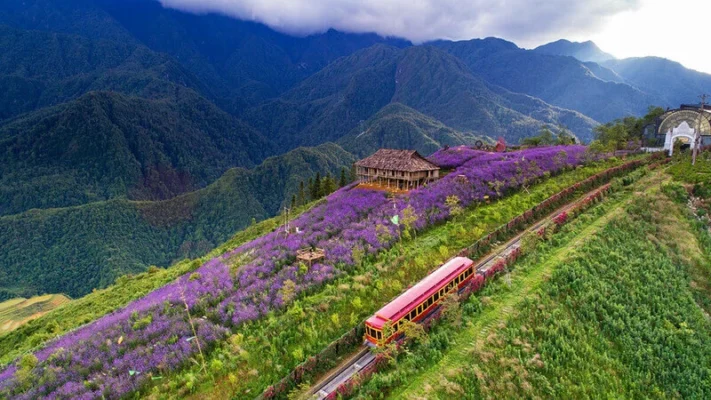
The train passes through Muong Hoa Valley
Muong Hoa Valley is one of the most breathtaking landscapes in Sapa, renowned for its stunning terraced rice fields that stretch across the hillsides. Visitors are treated to panoramic views of lush, layered fields that change colors with the seasons, from vibrant green during the growing phase to a golden hue during harvest time.
The valley is also dotted with traditional villages of the Hmong, Dao, and other ethnic groups, making it a prime spot for both photography and cultural exploration. A trek through the valley allows tourists to fully immerse themselves in the beauty of nature while experiencing the rural lifestyle of the local communities. The Sapa terraced fields are not just a visual spectacle but also a symbol of the hard work and ingenuity of the local farmers, who have cultivated these slopes for generations.
Do not miss: Things to do in Sapa
4. Sapa Weekend Market
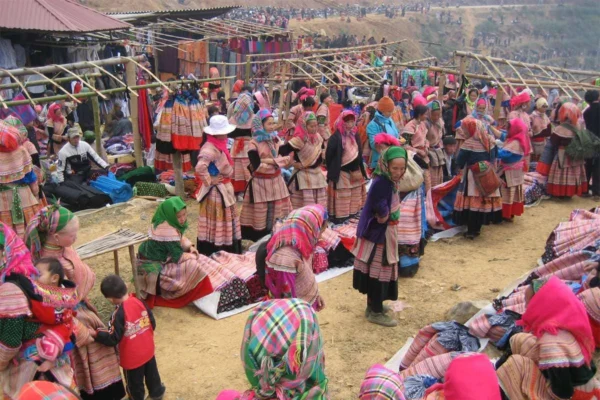
Sapa Weekend Market is imbued with local culture.
Sapa’s weekend market is a cultural highlight, offering a vibrant blend of colors, sounds, and flavors. Held in the town center, this market is a gathering place for ethnic minorities from surrounding villages, such as the Hmong, Dao, and Tay people. They come dressed in their traditional attire to sell handmade crafts, textiles, and local produce
For visitors, the market is a fantastic opportunity to purchase unique souvenirs, such as handwoven fabrics, silver jewelry, and herbal remedies. Beyond shopping, the market is a cultural experience in itself, offering insight into the traditions, customs, and daily lives of the ethnic communities.
You will be like: Shopping in Sapa
V. Experiences on the Hanoi to Sapa Tour
1. Trekking Through Villages
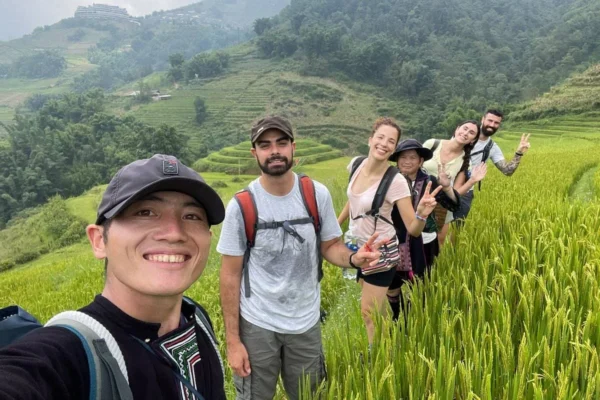
Sapa Trekking Hiking Tours
Trekking is one of the most iconic experiences when visiting Sapa. The most popular routes, such as Lao Chai, Ta Van, and Ta Phin, offer stunning views of terraced rice fields, rolling hills, and traditional villages.
- The Lao Chai-Ta Van trek takes you through the heart of the Muong Hoa Valley, where you can admire the lush green landscapes and witness the daily lives of the Black Hmong people. The trek usually starts from Sapa Town and winds through the serene countryside, providing endless photo opportunities.
- The Ta Phin trek is equally captivating, offering a chance to explore a Red Dao community. This trek combines picturesque scenery with the unique cultural practices of the Red Dao people, who are known for their colorful traditional clothing and herbal bathing techniques.
Click here: Northern Vietnam Wonders Tour
2. Cultural Exchange with Local Ethnic Communities
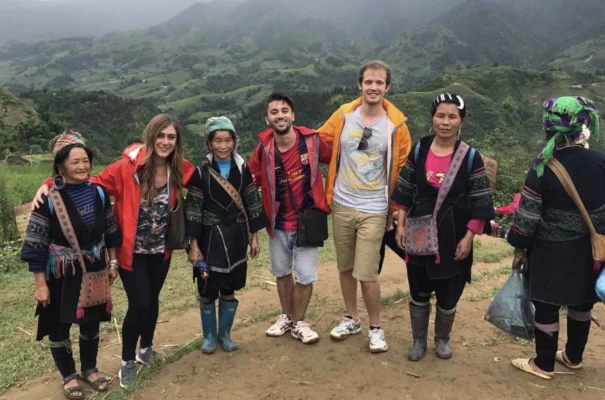
Meeting and interacting with ethnic minorities is an unforgettable experience.
A visit to Sapa is incomplete without immersing yourself in the rich cultural traditions of its diverse ethnic communities. The Hmong and Red Dao people are among the most prominent groups you’ll encounter during your journey. Many tours include home visits, where you can learn about traditional customs, family structures, and the daily routines of these indigenous communities.
Guests are often welcomed into local homes, allowing for a more intimate look at their way of life. You’ll gain insights into traditional crafts like indigo dyeing, intricate embroidery, and bamboo weaving. Interacting with local families not only enriches your travel experience but also provides a deeper appreciation of their resilience and hospitality in this remote, mountainous region.
Click here: Best homestays in Sapa
3. Savoring Local Cuisine
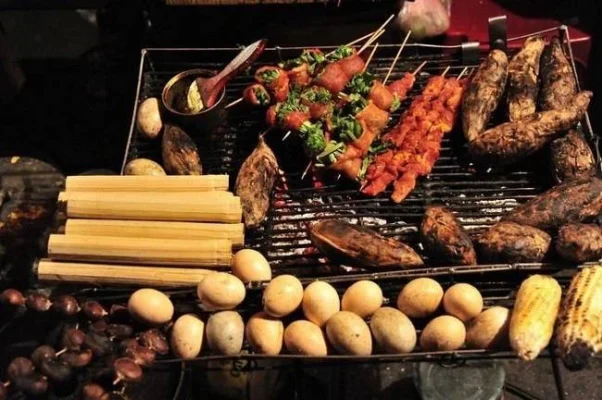
Don’t miss the rich cuisine of Sapa.
No trip to Sapa is complete without indulging in the region’s distinctive cuisine. The highland dishes are as unique as the landscapes, offering flavors that reflect the agricultural traditions and ethnic diversity of the area.
- One of the standout dishes is Thang Co, a traditional Hmong stew made with horse meat, organs, and a mix of fragrant herbs. This dish is often enjoyed at local markets and is considered a must-try for adventurous eaters.
- Another local specialty is grilled pork (often referred to as “ lợn cắp nách”), which features tender, flavorful meat marinated with spices and grilled to perfection. It’s commonly served with sticky rice, providing a satisfying meal after a day of trekking.
- For a truly authentic experience, try bamboo sticky rice (cơm lam), a dish made by stuffing sticky rice into bamboo tubes and slow-cooking it over an open fire. The result is a fragrant, slightly smoky rice with a unique texture.
- To complete your culinary adventure, don’t miss out on tasting apple wine (rượu táo mèo), a popular local drink made from wild mountain apples. Known for its tangy taste and warming effect, this drink is often enjoyed during family gatherings and festivals, providing a fitting conclusion to your cultural and gastronomic exploration in Sapa.
Learn more about: Sapa cuisine
VI. Best Time to Visit Sapa
1. Rice Harvest Season (September to November)
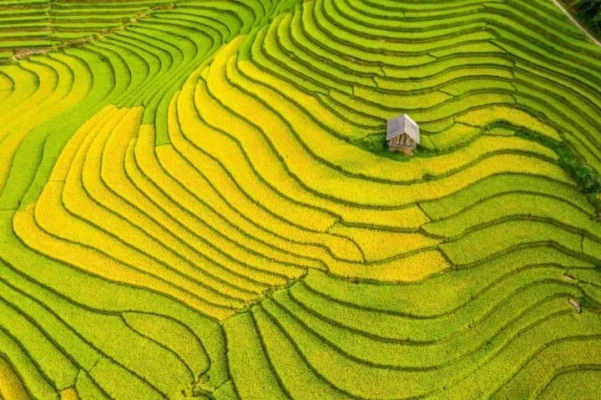
Rice Harvest Season in Sapa
- Overview: The period from late September to early November is considered one of the best times to visit Sapa. During this season, the terraced rice fields turn a vibrant golden hue as the rice ripens, offering breathtaking scenery and fantastic photo opportunities.
- Weather: Expect cool temperatures ranging from 15°C to 25°C (59°F to 77°F). The weather is generally dry, with clear skies and minimal rainfall, making it perfect for trekking and outdoor activities.
2. Plum and Peach Blossom Season (January to March)
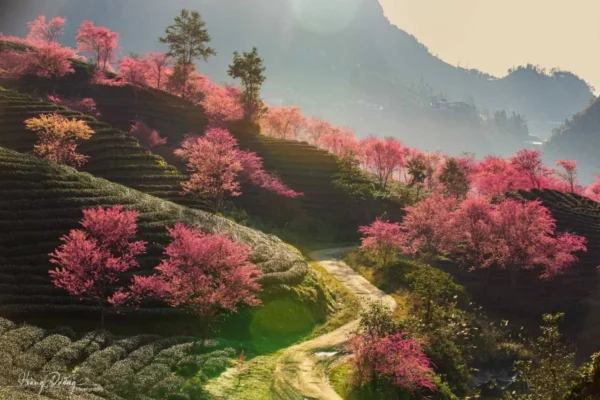
Plum and Peach Blossom Season
- Overview: Visiting Sapa between January and March offers a different but equally captivating experience. This period is marked by the blooming of plum and peach flowers, creating a picturesque landscape of white and pink blossoms.
- Weather: The temperatures are cooler, ranging from 8°C to 18°C (46°F to 64°F). It can be misty and foggy, adding a mystical charm to the scenery. There may be occasional light rain, so be prepared for varying conditions.
Read more: Sapa weather
VII. Benefits of Booking a Package Tour with Ula Travel
1. Convenience in Transportation and Flexible Itinerary
Booking a Hanoi to Sapa package tour offers significant convenience in terms of transportation. When you choose our package tour, you don’t have to worry about arranging transportation yourself. The tour operator takes care of all the logistics, from comfortable transfers between Hanoi and Sapa to local transportation within Sapa. This includes:
- Direct Transfers: Most package tours include direct transfers from Hanoi to Sapa, either by comfortable sleeper train, luxury bus, or private vehicle. This means you avoid the hassle of buying separate tickets, navigating local transport systems, or dealing with unexpected delays.
- Seamless Travel: Ula Travel coordinates all travel aspects, ensuring a smooth transition between different parts of your itinerary. This saves you time and reduces stress, allowing you to fully immerse yourself in the experience.
- Flexible Itinerary: Our tours offer flexibility in their schedules, allowing you to choose from various activities and excursions based on your interests and preferences. This means you can enjoy personalized experiences without having to plan every detail yourself.
2. Professional Support and Expert Guides
Another significant advantage of booking Ula Travel’s tour package is the availability of professional support and knowledgeable guides. Tour operators typically provide:
- English-Speaking Guides: Experienced guides who are fluent in English can enhance your experience by providing insightful commentary and answering any questions you might have. This ensures you understand the rich history and culture of Sapa and its surroundings.
- Local Expertise: Guides with in-depth local knowledge can offer unique insights into the region’s traditions, customs, and hidden gems. They can also help you navigate through local markets, interact with ethnic minority communities, and suggest the best spots for photos and relaxation.
- On-Ground Assistance: If any issues arise during the tour, such as health concerns or logistical problems, the guide and tour operator provide immediate assistance, ensuring a smooth and enjoyable experience.
3. Cost and Time Savings
Opting for a package tour can be more cost-effective and time-efficient compared to organizing the trip independently. Here’s how:
- Cost Savings: Package tours often include a variety of services bundled together, such as transportation, accommodation, meals, and guided tours. This can result in lower overall costs compared to booking each component separately. Tour operators often have agreements with hotels and transport providers, allowing them to offer discounted rates.
- Time Efficiency: Planning a trip to Sapa independently requires significant time and effort to research, book transportation, secure accommodations, and plan activities. A package tour streamlines this process by providing a pre-arranged itinerary, allowing you to focus on enjoying your trip rather than managing logistics.
- Comparative Analysis: While it’s possible to travel independently, doing so may involve higher costs for individual bookings and additional expenses for unexpected needs or changes. Package tours provide a clear and upfront cost structure, eliminating hidden fees and offering a more predictable budget.
In conclusion, a tour from Hanoi to Sapa provides an exceptional opportunity for international travelers to experience the breathtaking landscapes and rich cultural tapestry of northern Vietnam. From the stunning terraced fields and majestic Fansipan Peak to the vibrant local markets and traditional villages, Sapa offers a unique blend of natural beauty and cultural immersion.
Opting for a well-organized tour ensures a seamless and enriching experience, allowing you to fully appreciate the region’s highlights while benefiting from expert guidance. Whether you’re seeking adventure, cultural insights, or simply a scenic escape, a tour to Sapa promises an unforgettable journey that will leave you with cherished memories and a deeper connection to Vietnam’s diverse heritage.
See more: Sapa travel tips



